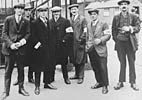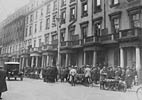After the First World War, workers in Britain's declining staple industries were faced with a concerted attempt by the employers to cut wages and increase productivity.
Due to the fact that the coal mining industry accounted for a sixth of the male labour force and was the strongest and best organised in trade union terms, miners were at the centre of the employers' offensive and bore the main brunt of the post war attack. During the war the State had assumed some measure of control over mining as an essential war time industry.
This had boosted the miners' demand for the nationalisation of the industry. However, after the war the coal owners announced savage wage cuts to well below pre-1914 levels and an ending of national wage agreements.
Employers in other industries were attempting similar tactics.
Professor Mary Davis, Centre for Trade Union Studies, London Metropolitan University
Click here to view documents and pictures









